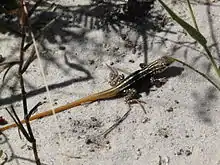Heliobolus lugubris
Heliobolus lugubris, also known commonly as the bushveld lizard, mourning racerunner, or the black and yellow sand lizard, is a species of lizard in the family Lacertidae. The species is native to southern Africa.[2]
| Bushveld lizard | |
|---|---|
.jpeg.webp) | |
 | |
| adult and juvenile | |
| Scientific classification | |
| Kingdom: | Animalia |
| Phylum: | Chordata |
| Class: | Reptilia |
| Order: | Squamata |
| Family: | Lacertidae |
| Genus: | Heliobolus |
| Species: | H. lugubris |
| Binomial name | |
| Heliobolus lugubris | |
| Synonyms | |
|
Eremias lugubris Duméril & Bibron, 1839 | |
Mimicry
Juveniles of H. lugubris are black with light spots and move with a hunched gait, mimicking the appearance of Anthia ground beetles. This mimicry is thought to discourage predation, as the beetles spray formic acid as a defense mechanism and are thus less appealing targets for predators. This is one of very few recorded examples of a vertebrate mimicking an invertebrate.[3]
References
- Smith, Andrew (1838). "Contributions to the Natural History of Southern Africa". Magazine of Natural History. 2: 93. (Lacerta lugubris, new species).
- "Heliobolus lugubris (SMITH, 1838)". Reptile Database. Retrieved 21 April 2015.
- Huey, RB; Pianka, ER (January 1977). "Natural selection for juvenile lizards mimicking noxious beetles". Science. 195 (4274): 201–203. Bibcode:1977Sci...195..201H. doi:10.1126/science.831272. PMID 831272.
Further reading
- Branch, Bill (2004). Field Guide to Snakes and other Reptiles of Southern Africa. Third Revised edition, Second impression. Sanibel Island, Florida: Ralph Curtis Books. 399 pp. ISBN 0-88359-042-5. (Heliobolus lugubris, p. 161 + Plate 57).
This article is issued from Wikipedia. The text is licensed under Creative Commons - Attribution - Sharealike. Additional terms may apply for the media files.